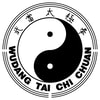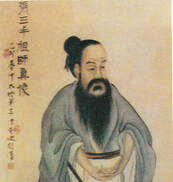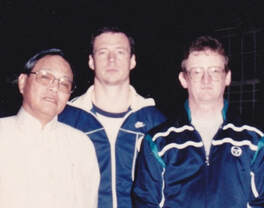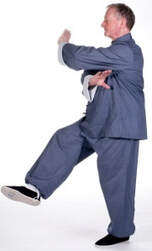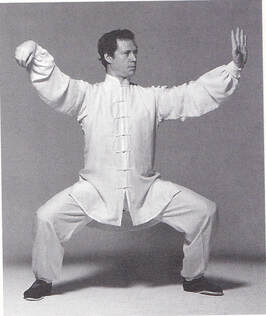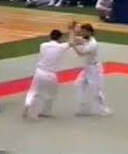Tai Chi Chuan (to give it its full name, ‘Chuan’ meaning fist) is a martial art and is still practised as such at Practical Tai Chi Chuan, and Five Winds Tai Chi Chuan. However, the majority of those practicing tai chi now-a-days are seeking its renowned health benefits and limit their learning to Qigong, Hand Form, and possibly Push Hands. In fact there are Five Aspects to Tai Chi Chuan.
Regular tai chi practice has been proven to relax the body, improves balance and coordination, and leads to better respiration and circulation. Indeed, recent research concluded that 12 weeks of tai chi can relieve the symptoms of rheumatoid arthritis, including less pain and stress, more body awareness, and more confidence in moving; check out BBC’s ‘Michael Mosley puts tai chi to the test’.
The good news is that almost anyone can practise at least some aspect of tai chi. The most popular, or better known aspect of the art of tai chi chuan is the hand form, a set of moves preformed in a slow, flowing and relaxed manner. The Tai Chi Chuan Hand Form, with its graceful and flowing movements and alert actions, resembles a classic dance. Yet it is a sophisticated method of integrated whole body movement, that is, body and mind are one and move as such, with focus and intent.
Over a period of time, the central nervous system will be stimulated by the tranquil state of mind and dedicated concentration on the movements. The movements offer a balanced drill for the body's muscles, tendons and joints, and serves to increase the well-being of all the organs of the body as their efficient functioning depends very largely on a sound central nervous system. Moving slowly with awareness and presence promotes all of these benefits; practitioners are encouraged to focus on the slow, soft, self-conscious feeling of movement. Movement that is essentially martial in intent yet directed by a knowing mind, attentive to the sensation of movement, in this moment, in this breath, ‘feeling’ one’s way through the movements of the hand form.
Tai Chi is nature's perfect blend of psyche (mind) and soma (body) in which the practice of attention regulation promoted by slow movement practices combines with the body's readiness to direct its resources toward healing. It can only do that if we reduce stress, slow down, and pay attention, as Jon Kabat-Zinn says,
“The attitude with which you undertake the practice of paying attention and being in the present
is crucial. It is the soil in which you will be cultivating your ability to calm your mind and to relax
your body, to concentrate and to see more clearly."
Tai Chi initially involves training the body in movement by learning exercises, postures, forms and drills; through this you learn to focus the mind and develop intent. Next you explore coordination of the external movement and postures with the internal, to develop respiration, circulation, vitality and spirit.
A Foundation class starts with soft stretching exercises from a Qigong (Chi Kung) routines, the most popular of which are Shibashi and Eight Pieces of Brocade. This facilitates deep physical relaxation, either in motion or in stillness. 'Letting go' our learned 'holding on' to stress and tension is the prerequisite for the smooth and balanced distribution of energetic resources throughout the body. And the longer you practice, the more you begin to refine your physical movement, your breath and your mental state. Michael Acton (‘Eternal Spring’) says,
“Qi Gong teaches energetic conservation and the distribution of our energetic resources to prioritize
conservation, repair and replenish. This can become a way of life and can both improve and change
our daily life and how we deal with conflict and physical stress.”
Tai Chi at Foundation classes is health oriented, facilitating gentle exercise and encouraging relaxed, synchronized movement. The curriculum includes Qigong, Hand Form, and basic Push Hands. Those folk wanting a more comprehensive and demanding activity are recommended to consider Five Winds and Practical tai chi.
Of course people who practice tai chi well make it look easy and effortless, but this is the result of regular practice and effort. Like most things worth learning it can be difficult at first but with practice and encouragement it does become easier.
"The trying to do something is itself enlightenment"
Shunryn Suzki, Zen Mind, Beginner's Mind
Regular tai chi practice has been proven to relax the body, improves balance and coordination, and leads to better respiration and circulation. Indeed, recent research concluded that 12 weeks of tai chi can relieve the symptoms of rheumatoid arthritis, including less pain and stress, more body awareness, and more confidence in moving; check out BBC’s ‘Michael Mosley puts tai chi to the test’.
The good news is that almost anyone can practise at least some aspect of tai chi. The most popular, or better known aspect of the art of tai chi chuan is the hand form, a set of moves preformed in a slow, flowing and relaxed manner. The Tai Chi Chuan Hand Form, with its graceful and flowing movements and alert actions, resembles a classic dance. Yet it is a sophisticated method of integrated whole body movement, that is, body and mind are one and move as such, with focus and intent.
Over a period of time, the central nervous system will be stimulated by the tranquil state of mind and dedicated concentration on the movements. The movements offer a balanced drill for the body's muscles, tendons and joints, and serves to increase the well-being of all the organs of the body as their efficient functioning depends very largely on a sound central nervous system. Moving slowly with awareness and presence promotes all of these benefits; practitioners are encouraged to focus on the slow, soft, self-conscious feeling of movement. Movement that is essentially martial in intent yet directed by a knowing mind, attentive to the sensation of movement, in this moment, in this breath, ‘feeling’ one’s way through the movements of the hand form.
Tai Chi is nature's perfect blend of psyche (mind) and soma (body) in which the practice of attention regulation promoted by slow movement practices combines with the body's readiness to direct its resources toward healing. It can only do that if we reduce stress, slow down, and pay attention, as Jon Kabat-Zinn says,
“The attitude with which you undertake the practice of paying attention and being in the present
is crucial. It is the soil in which you will be cultivating your ability to calm your mind and to relax
your body, to concentrate and to see more clearly."
Tai Chi initially involves training the body in movement by learning exercises, postures, forms and drills; through this you learn to focus the mind and develop intent. Next you explore coordination of the external movement and postures with the internal, to develop respiration, circulation, vitality and spirit.
A Foundation class starts with soft stretching exercises from a Qigong (Chi Kung) routines, the most popular of which are Shibashi and Eight Pieces of Brocade. This facilitates deep physical relaxation, either in motion or in stillness. 'Letting go' our learned 'holding on' to stress and tension is the prerequisite for the smooth and balanced distribution of energetic resources throughout the body. And the longer you practice, the more you begin to refine your physical movement, your breath and your mental state. Michael Acton (‘Eternal Spring’) says,
“Qi Gong teaches energetic conservation and the distribution of our energetic resources to prioritize
conservation, repair and replenish. This can become a way of life and can both improve and change
our daily life and how we deal with conflict and physical stress.”
Tai Chi at Foundation classes is health oriented, facilitating gentle exercise and encouraging relaxed, synchronized movement. The curriculum includes Qigong, Hand Form, and basic Push Hands. Those folk wanting a more comprehensive and demanding activity are recommended to consider Five Winds and Practical tai chi.
Of course people who practice tai chi well make it look easy and effortless, but this is the result of regular practice and effort. Like most things worth learning it can be difficult at first but with practice and encouragement it does become easier.
"The trying to do something is itself enlightenment"
Shunryn Suzki, Zen Mind, Beginner's Mind
